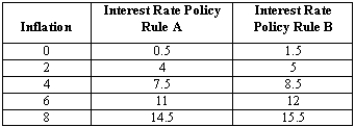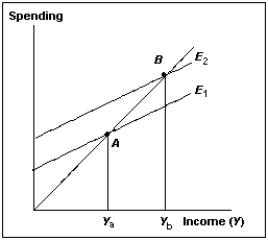A) buying and selling bonds.
B) mandating that banks change the prime rate.
C) recommending that the president change the interest rate.
D) recommending that Congress change the interest rate.
E) increasing the required reserve ratio.
Correct Answer

verified
Correct Answer
verified
Multiple Choice
If the central bank increases the target inflation rate,then
A) the monetary policy rule line will become steeper.
B) there will be movement along the monetary policy rule line.
C) the monetary policy rule line will shift down.
D) the monetary policy rule line will shift up.
E) the monetary policy rule line will become flatter.
Correct Answer

verified
Correct Answer
verified
True/False
Aggregate expenditures depend on the nominal interest rate because that is the rate that must be paid to the borrower.
Correct Answer

verified
Correct Answer
verified
True/False
The AD curve slopes down because there is more spending when inflation is lower.
Correct Answer

verified
Correct Answer
verified
Multiple Choice
In the United States,inflation is the responsibility of
A) the market.
B) the president.
C) the Federal Reserve.
D) Congress.
E) the U.S.Treasury.
Correct Answer

verified
Correct Answer
verified
Multiple Choice
The equation for the real interest rate indicates that,other being things equal,
A) as inflation increases,the nominal interest rate will fall.
B) as inflation increases,the real interest rate will rise.
C) as inflation decreases,real income will fall.
D) as inflation changes,the real interest rate will not change.
E) as inflation decreases,the real interest rate will rise.
Correct Answer

verified
Correct Answer
verified
True/False
If a change in interest rates will affect real GDP,the Fed should focus on the change in the nominal interest rate.
Correct Answer

verified
Correct Answer
verified
Multiple Choice
Which of the following facts about investment is not true?
A) Investment is the component of expenditure that is least sensitive to the real interest rate.
B) Investment represents the purchase of new equipment or a new factory by a business firm.
C) Investment generally decreases when the real interest rate increases.
D) All of the above represent true facts about investment.
E) None of the above represent true facts about investment.
Correct Answer

verified
Correct Answer
verified
Multiple Choice
The aggregate demand curve and the inflation adjustment line intersect where real GDP is
A) less than,equal to,or greater than potential GDP.
B) less than potential GDP.
C) greater than or equal to potential GDP.
D) greater than potential GDP.
E) equal to potential GDP.
Correct Answer

verified
Correct Answer
verified
True/False
The Fed issues a statement right after every FOMC meeting whether the interest rate changes or not.Economists and financial analysts study the wording of the statements carefully,trying to ascertain what the Fed's next move is going to be.
Correct Answer

verified
Correct Answer
verified
True/False
Inflation and the rate of interest are positively correlated.
Correct Answer

verified
Correct Answer
verified
Multiple Choice
The housing boom that took place during the first half of the 2000s best illustrates how
A) investment spending by households is insensitive to changes in the real interest rate.
B) fixed investment spending by businesses is sensitive to changes in the real rate of interest.
C) investment spending by households is sensitive to changes in the real rate of interest.
D) consumption expenditures are sensitive to changes in the real rate of interest.
E) fixed investment spending by businesses is insensitive to changes in the real rate of interest.
Correct Answer

verified
Correct Answer
verified
Multiple Choice
Exhibit 24-3  -If the central bank changes its monetary policy rule from A to B as shown in Exhibit 24-3,
-If the central bank changes its monetary policy rule from A to B as shown in Exhibit 24-3,
A) the AD curve will shift to the left.
B) there will be a downward movement along the AD curve.
C) there will be no change since the real rate of interest does not change.
D) the AD curve will shift to the right.
E) there will be an upward movement along the AD curve.
Correct Answer

verified
Correct Answer
verified
True/False
The economic fluctuations model is older than the supply and demand model.
Correct Answer

verified
Correct Answer
verified
Multiple Choice
Which of the following would be most likely to result in an upward shift of the inflation adjustment line?
A) A fall in the target interest rate
B) An increase in taxes
C) A fall in consumer confidence
D) An increase in imports
E) An increase in commodity prices
Correct Answer

verified
Correct Answer
verified
Multiple Choice
Exhibit 24-2  -Which of the following is a valid explanation of the expenditure line shift from E1 to E2 in Exhibit 24-2?
-Which of the following is a valid explanation of the expenditure line shift from E1 to E2 in Exhibit 24-2?
A) A decline in government purchases
B) An increase in taxes
C) An increase in the interest rate
D) A decline in the value of the dollar
E) A fall in world interest rates
Correct Answer

verified
Correct Answer
verified
Multiple Choice
The inflation adjustment line IA will shift down if
A) the local currency depreciates against foreign currencies.
B) real GDP rises above potential GDP.
C) real GDP falls below potential GDP.
D) All of the above
E) None of the above
Correct Answer

verified
Correct Answer
verified
Multiple Choice
Real interest rates and investment are
A) negatively correlated because higher real interest rates make it easier for the firm to borrow funds.
B) negatively correlated because higher real interest rates will increase the firm's profits.
C) positively correlated because higher real interest rates make it easier for the firm to borrow funds.
D) negatively correlated because higher real interest rates make borrowing by firms more costly.
E) positively correlated because higher real interest rates make borrowing by firms less costly.
Correct Answer

verified
Correct Answer
verified
True/False
The intersection of the inflation adjustment line and the aggregate demand curve may give values of real GDP that may be above potential GDP,but never below.
Correct Answer

verified
Correct Answer
verified
True/False
Because of various shocks to the economy,the central bank cannot control the inflation rate perfectly,particularly in the short run.
Correct Answer

verified
Correct Answer
verified
Showing 121 - 140 of 207
Related Exams